Wait, hear me out!
I started to think about this blog post topic based on an recent incidental conversation I had with my friend Marta. She and I both happen to love playing games. Cards (particularly euchre and shanghai rummy), dice, board games, trivia, name that tune, anything really… and our latest recent obsession: e-Ticket to Ride.
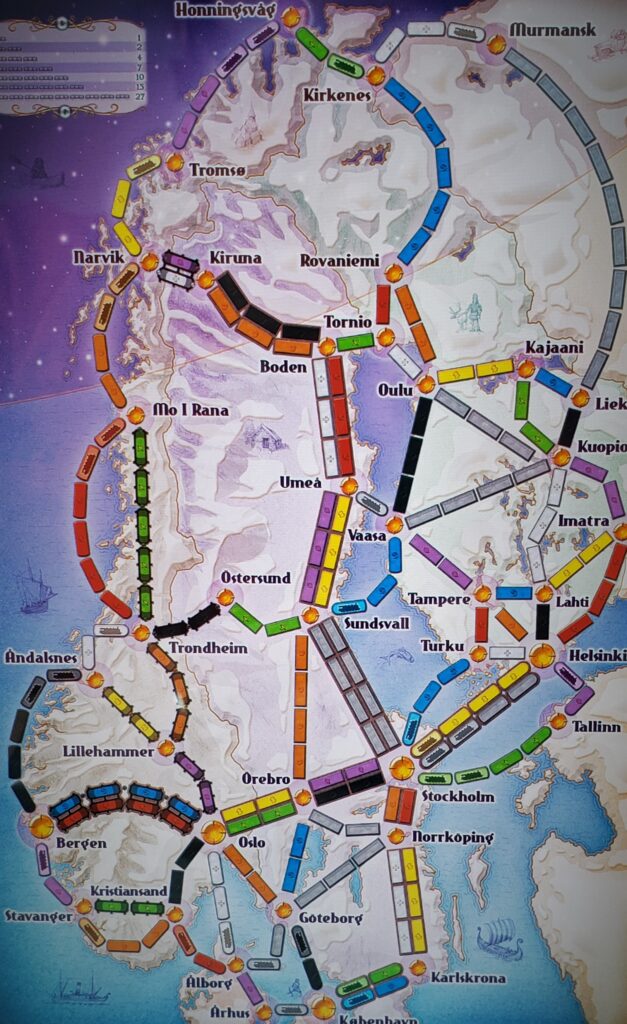
We play the online version in a group with Peter and sometimes Tammy, on our tablets, and have our mobile phones running a WhatsApp video call at the same time! A bandwidth intensive high tech solution to enjoying an old fashioned train route building contest. Its satisfyingly close to actually sitting at the table and playing a board game together! The first time we played, a week or so ago, had a profound effect on me in this time of pandemic-induced physical distancing. It felt re-affirmingly human to socially connect and have a little lightly competitive fun with people outside our few, by now well-worn, rooms in this Oulu apartment. Marta and I both have a history of lakeside cottage life, where playing (old fashioned person to person, non-electronic) games is an integral part of passing the time while cementing friendships, family relationships, and “unplugging” from our more urban, tech-laden jobs. Games are just good medicine.

As we laid our train cars onto the tracks, our conversation turned to her wedding to Peter, summer 2017, in Scotland. I shared with her that I vividly recalled a game called Kubb (said like “tube”) that our friend Julie’s father, Idso, had taught us on the expansive lawn of Springkell Manor estate. Idso was excited to have willing participants, and was an excellent teacher, mostly because he was really good. Kubb, he taught us, is a Scandinavian game where people facing each other on two sides of a field toss a wooden baton at their opponents’ smaller wooden skittles (kubbs) with the intention of clearing them all and knocking down the “king”, which sits in the middle. It is sometimes referred to as ‘Viking Chess’, and is actually quite challenging and fun, yet simple. The pieces can be handmade, and the game kit is very portable. Thinking back on that special July day made me wonder… what is the history of a game like Kubb, and is there a Finnish analogue?
Many rabbit holes and lots of reading later, it turns out that ‘games’ aren’t just fun and games! I believe they represent nothing less than our living, interactive, identity reinforcing cultural heritage. European (and thus North American) “tossing” or “bowling” style lawn games may be traced as far back as the ancient Egyptians, and later to bored Roman soldiers who used their war horse’s old shoes as game pieces to toss at stakes. In that same vein, Quoits uses rope rings, while Irish rings are tossed at a board hung on a wall, complete with a point system much like today’s dart games (and aren’t rings much safer in a pub than darts!?). Washer Pitching and Cornhole (Bags) are natural extensions of that line of game heritage.
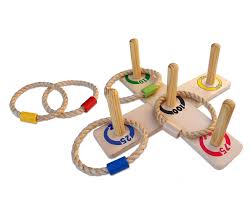
Quoits 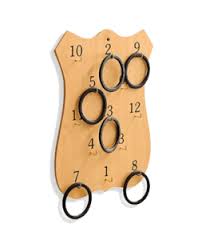
Irish Rings 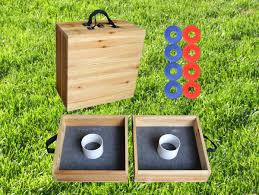
Washer Pitching 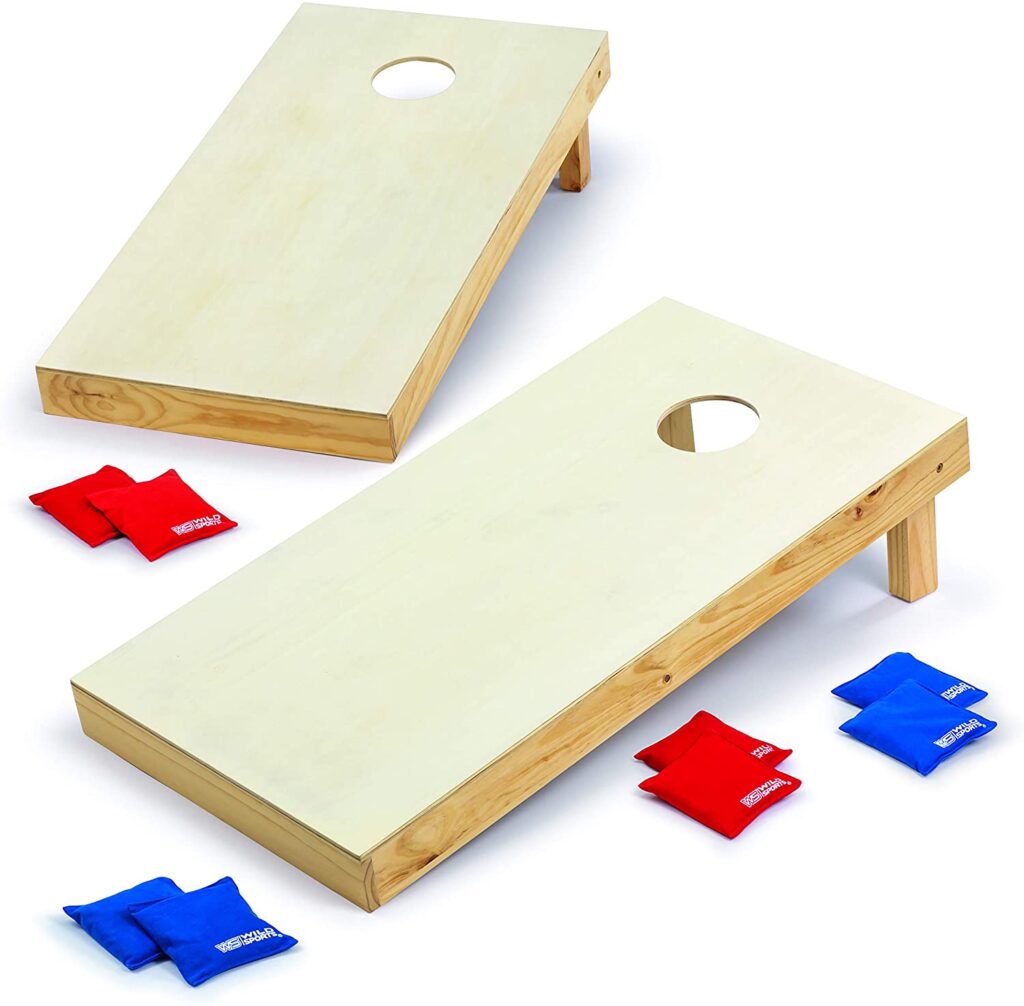
Cornhole Set
Other early tossing games include Scottish Caber tossing, a version of which we played in the Highland games at the wedding.
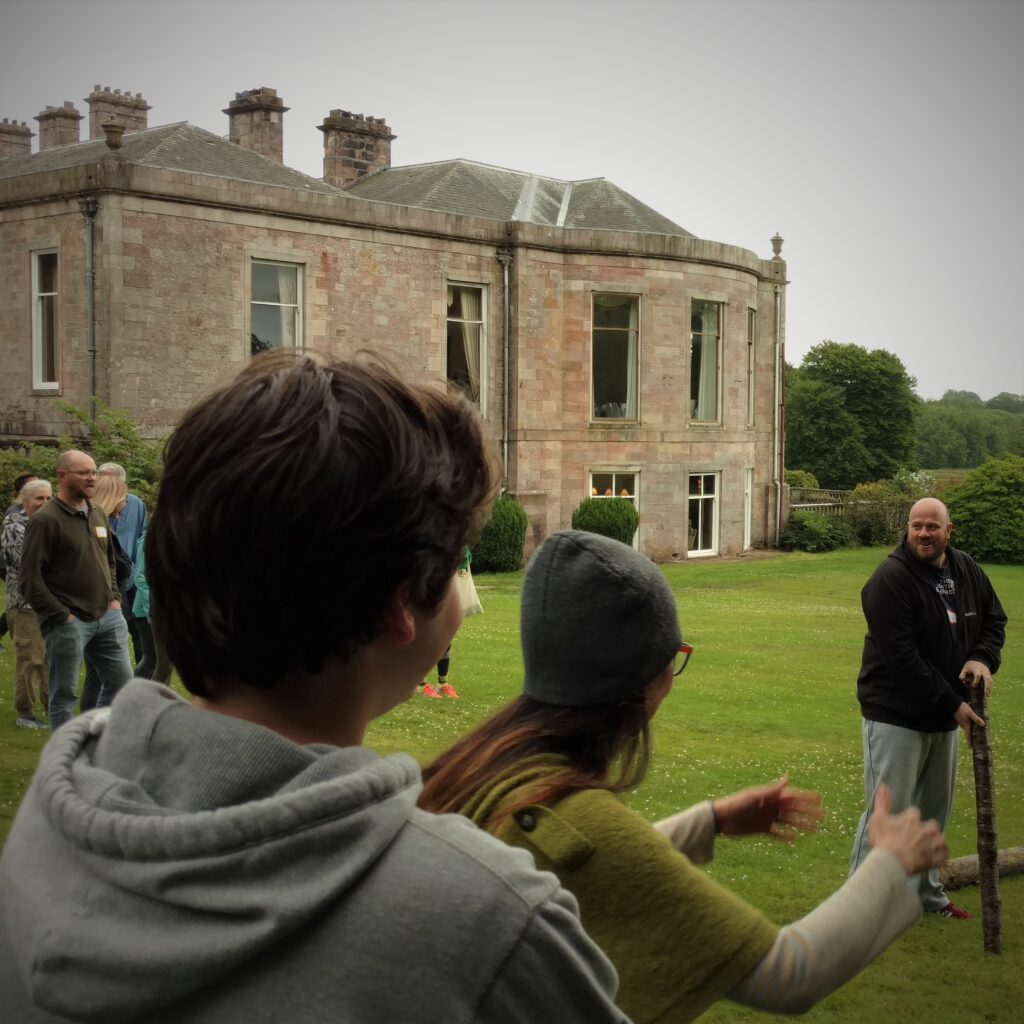
Bunnock or bones, which features horse ankle bones as the skittles, is currently popular in Canada (they use resin replicas these days), but is believed to have Russian origin. Kubb appears to be a skittles game descended from bunnock, and this ancestral line produced the first of the Finnish-specific games I found: Karelian Skittles (kyykkä). Karjala (in Finnish) is a region between Russia and Finland, formerly Finnish, but mostly consumed by Russia in the treaty deal after WWII. Both horseshoes and horse ankle bones would have been much more expensive and difficult to obtain when compared to plentiful poplar and pine trees, thus the game pieces made in more forested, less affluent places are indeed wooden. It’s not difficult to see how a Russian game of bones moved into Karjala, morphed economically and culturally and emerged as something tailored to Finns and their forests. Alas, kyykkä was believed to have been fading into obscurity and was only played in remote villages by the time our old friend Elias Lönnrot was traveling around collecting poems for his Kalevala in the mid 1800s. However, In 1951 there was a movement to save and revitalize the renamed ‘Finnish skittles’ with the approval of then President Urho Kekkonen. A modern set of rules and a scoring system were created, taking into account the original traditional Karelian skittles game. The Finnish Skittles Association actively holds regional matches and tournaments to this day.
In a different-but-kindred lineage of the game family tree, at the crossroads of the tossing meets bowling meets billiards branches, a British skittles game developed into not only a large lawn-sized version, but shrunken indoor bar-sized versions based on cultural need (weather, pub-going habits). Another ancient Russian / Baltic folk tossing game is Gorodki (little cities) in which the tossers baton aims to disrupt an arrangement of 5 skittles shaped into one of 15 configurations, i.e. a canon, a fork or a star, etc. An appropriately intellectually militaristic yet artistic Russian slant. These games have more of a bowling feel to them in that one ball or baton thrown at many skittles for the purpose of not just knocking them down, but also to obtain the best score value. It is of this lineage that I found a second uniquely Finnish game: Mölkky (pronounced: muel ku). The name is made-up, but likely comes from the Finnish word pölkky which means ‘block’.
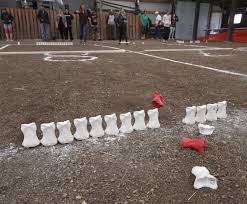
Bunnock (horse ankle bones!?) 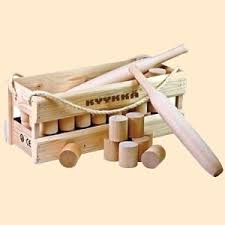
A kyykkä (Finnish skittles) set in its carrying box 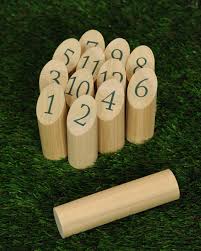
Mölkky skittles setup and baton ready to toss 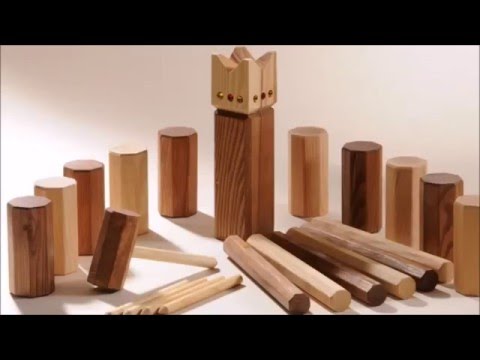
A Kubb (Viking Chess) set
A wooden game set packed in a distinctive carrying crate, Mölkky has the tosser throwing the baton at a batch of numbered skittles placed in a particular starting order and shape, rather like a rack of billiard balls. The winner is first to 50 points exactly. Going over 50 amounts to losing half, and the player starts their next round at 25 points. It feels like in Finland, there may be a bit of cultural ‘shaming’ that happens when an ‘everyman’s’ score gets too high. Is that the way it is, to some degree, in real life here too? Remember “Everyman’s Rights”? these could be loosely related notions, and again point to games as reminders of cultural identity. In any case, Mölkky has relatively recently (1990s) been commercialized and is really quite popular, complete with annual international tournaments!
Is it much of a leap, then, to find out that the Finnish company Rovio.com adapted its very own country’s ‘baton tossed at skittles’ games of kyykkä and mölkky into an electronic mobile game? Who better than the highly educated, tech savvy Finns to hunker down inside during the long cold winters and develop cute catchy software that lets game players use their phones to toss bird batons at pig skittles for points? The birds are even bright red, just as the ‘batons’ are in bunnock. Angry Birds was released for mobile devices in 2009 during the swine flu epidemic, making pigs the perfect enemy. (Sound familiar? Maybe they’ll make a covid-19 version using bats or pangolins!?) The game went virally popular, introduced low per game price points, established mobile gaming as a credible business effectively launching an entire industry, and has itself grown into an enormous franchise including sequel games, movies, cartoons, and theme parks…
What ancient Roman occupying soldier could have imagined, as they listened to the clinks and clanks of used horseshoes circling the stake, that these country-specific, culturally tailored games would be played in the distant, but related future?
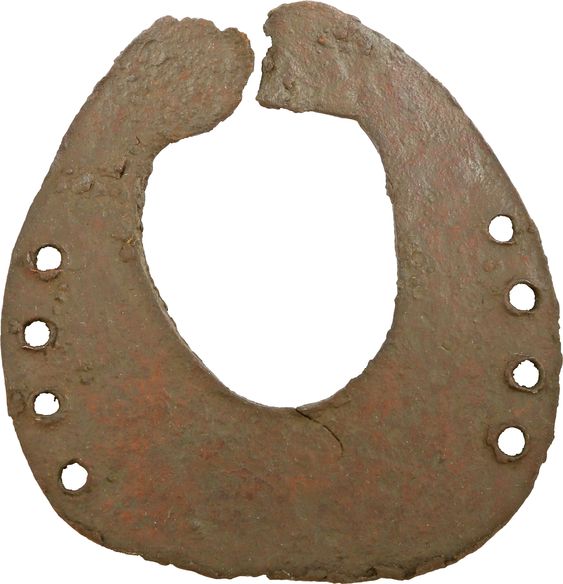
Ancient round horseshoe 
Angry Birds ‘baton’ 
Viral Pig ‘skittle’
Special thank you to Marta Van der Mer-Telleman and Idso Wiersma as the inspirations for my game family tree research. Go find some friends or family and play a game. Use a conference call or a zoom meeting or skype or WhatsApp… I promise you’ll be happy you did.

Idso demonstrating the perfect Kubb toss on the lawn at Springkell… 
Marta… playing a game of course!
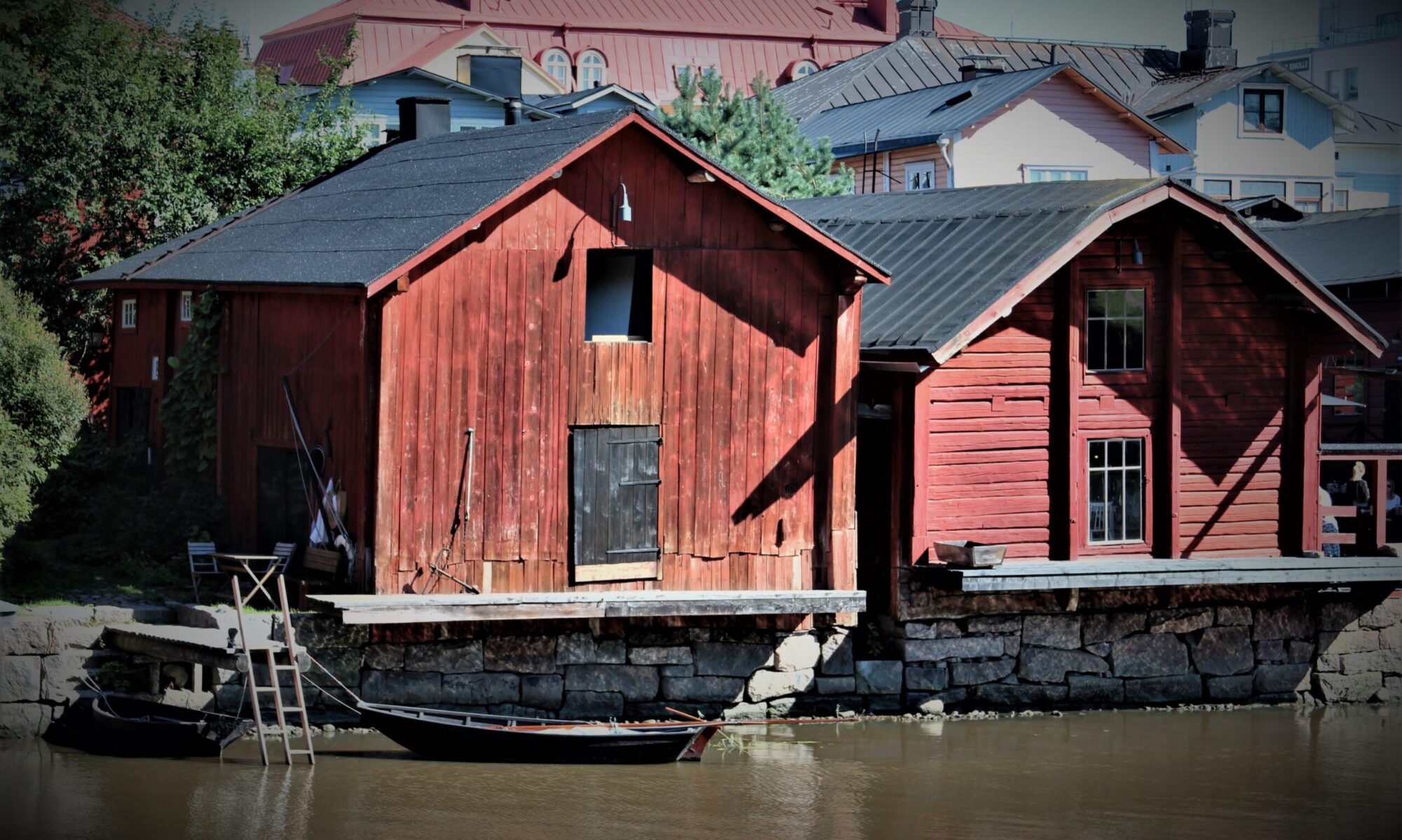
You are a natural. Really well written weaving in history, pictures and personal anecdotes. Good stuff.
Way to suck me in… Write a story that includes me. Ha ha. Well, I do love games and a good story with historical relevance that is true! So, thank you for providing both! It was a pleasure to read.
The common denominator in all these games seems to be throwing something at something else. I like that!
Just curious, do you think there may be any Finnish roots in Mahjongg? There is a real temptation to throw the tiles when we lose.
Love that picture of beautiful Flanders Lake! Heading there next weekend and will open up “ le bunkhouse”!
Keep the tales coming, love to read your news.
Very impressive reading, Karin! Stay healthy and safe, my friend!